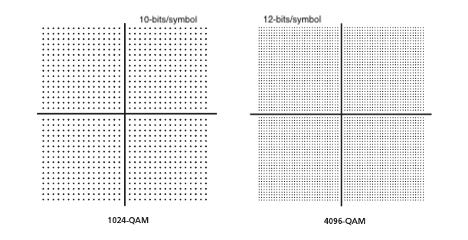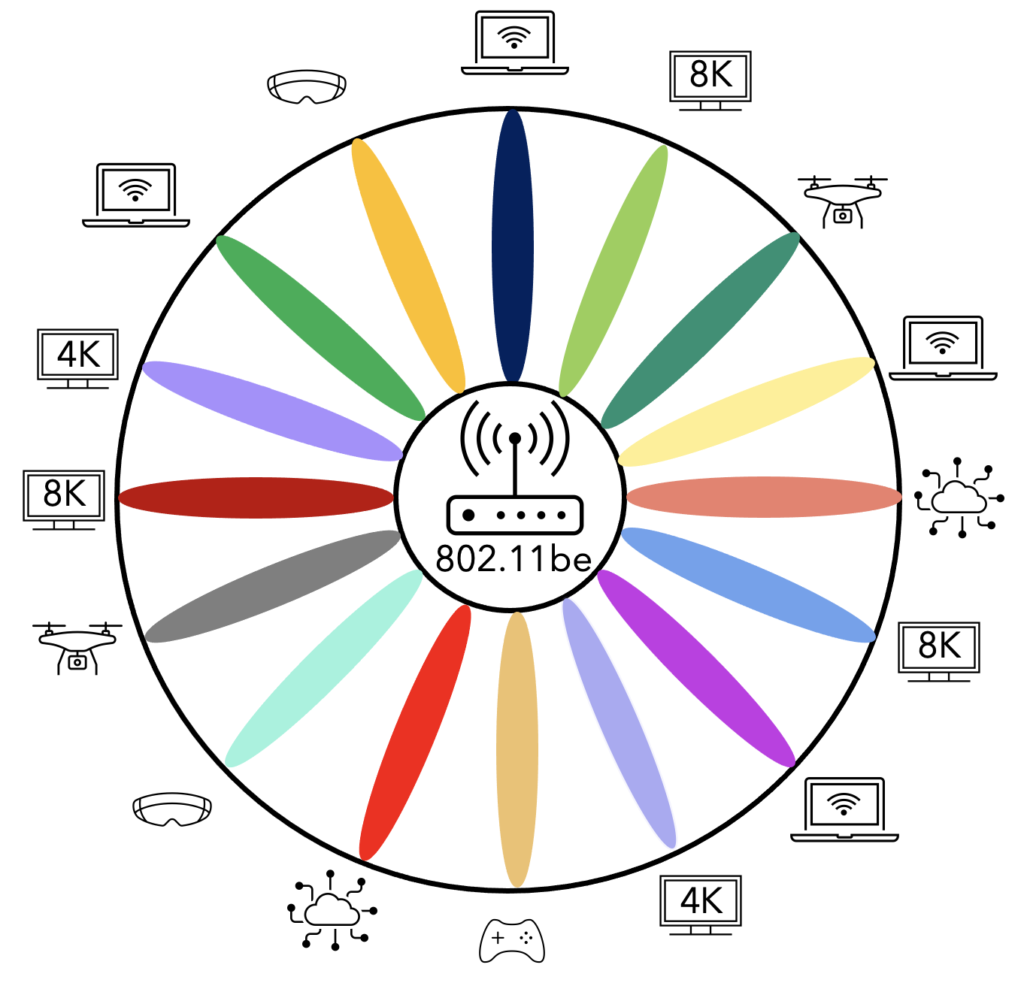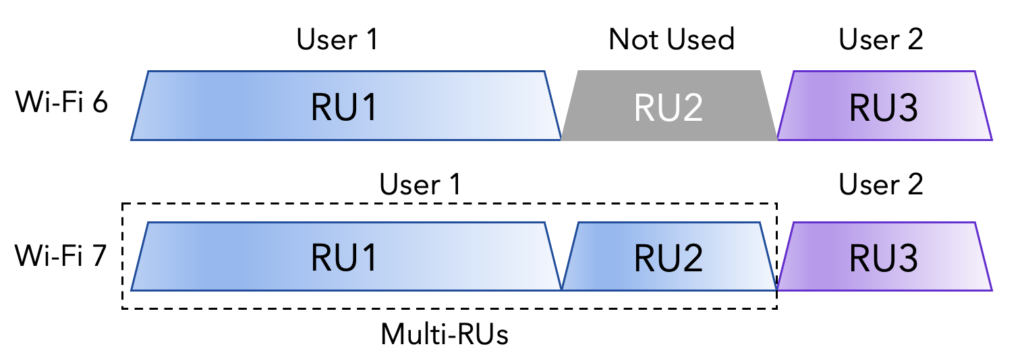Wi-Fi 7 (802.11be) Highlights
Wi-Fi 7 is slated to be the next release of the Wi-Fi standard from the IEEE final WG approval scheduled for May 2024, Also known as 802.11be – Extremely High Throughput (EHT), Wi-Fi 7describes tri-band operation across all three Wi-Fi bands – 2.4, 5, and 6GHz.
To live up to the title of Extremely High Throughput, the following enhancements will be introduced with Wi-Fi 7:
- 320MHz ultra-wide channels
- 4K-QAM
- Multi-Resource Unit (MRU)
- Preamble puncturing
- Multi-Link Operation (MLO)
| Wi-Fi 6 | Wi-Fi 6E | Wi-Fi 7 | |
|---|---|---|---|
| Ratification Date | 2019 | 2021 (FCC approves 6 GHz) | 2024 (scheduled) |
| IEEE standard | 802.11ax | 802.11ax | 802.11be |
| Spectrum Used | 2.4 & 5 GHz | 6 GHz | 2.4, 5, & 6 GHz |
| Spatial Stream MU-MIMO (max) | 8 x 8 UL/DL | 8 x 8 UL/DL | 16 x 16 UL/DL |
| MLO | No | No | Yes |
| Puncturing | No | No | Yes |
| QAM (max) | 1024 (1K) | 1024 (1K) | 4096 (4K) |
| Data Rate (max) | 9.6 Gbps | 9.6 Gbps | 46 Gbps |
| Channel Width (max) | 160 MHz | 160 MHz | 320 MHz |
| Resource Units | RU | RU | Multi-RU |
True Tri-band support
802.11ax did support all three bands, but due to regulatory delays, the IEEE standard was subdivided into two wireless certifications by the Wi-Fi Alliance (WFA). Wi-Fi 6 certified IEEE 802.11ax hardware on the 2.4 and 5 GHz bands, while Wi-Fi 6E extended IEEE 802.11ax certification into the 6GHz band. Evolving capabilities on all three bands continues to be a focus with Wi-Fi 7.
Show me the QAMs
Keeping with tradition and fulfilling the need for speed, 4096-QAM has been added to the PHY allowing upward of a 20% speed boost during successful communication attempts.
Furthering peak rates, Wi-Fi 7 adds a higher rate using a higher complexity modulation scheme of 4096-QAM. At this rate, each symbol will be capable of carrying 12 bits, offering a 20% improvement over the 10-bit maximum available in Wi-Fi 6.

4 lanes good, 8 lanes better – ultra-wide channels
One of the easiest ways to increase throughput is to use wider channels. Wi-Fi 7 adds support for 320MHz. With over 1200 MHz of spectrum available, there appears to be lots of spectrum to go around – but with this change, the pendulum is swinging back to adding features that can be listed on paper but will offer little benefit in the enterprise.
For single family home-style (or non-MDU) consumer spaces where only 2-3 neighbouring (rogue) APs are heard, there is potential for this feature to offer increased speed and performance. However, in the enterprise environment, where channel plans must be carefully thought out, using overly wide channels compromises channel plans and adds too much opportunity for co-channel interference. It will be challenging enough in low power indoor (LPI) environments where the full 6GHz band can be used, and even more damaging when standard power (SP) radios are deployed with directional antennas or when mounted outdoors.
Wider channels must always be balanced while minimizing co-channel interference. A good philosophy is to configure as wide a channel as you can… until you can’t. Unfortunately, the threshold for measuring “when you can’t” quickly becomes a greater concern during periods of high utilization or in proximity of neighbours with competing Wi-Fi networks. During periods of low use or in environments with poorly configured neighbouring networks, features like preamble puncturing and MLO can offer benefits.

Preamble Puncturing
Previously, wider channels could not be used unless the entire channel was free. With wider channels enabled, data would only be sent on the primary 20MHz if any of the non-primary 20MHz channels making up a wider channel were busy. With preamble puncturing, the busy channel(s) can be blocked (or punctured from the wider channel) allowing radios to leverage the clear channel blocks across a wider channel width. Preamble puncturing makes the use of wider channels more attractive with greater potential for realizing performance benefits from enabling wider channels.

Multilink Operation (MLO)
Perhaps one of the coolest features within Wi-Fi 7, and something that distinguishes it uniquely from past amendments, is multilink optimization.
Traditionally, Wi-Fi behaved like a hub, operating in half-duplex mode, only one device could transmit at any given moment and everyone on a segment could hear everyone else talking. Multi-link operation adds support for operations in full-duplex mode allowing radios to transmit and receive on different bands or channels. While the burden of CSMA/CA increases, performance benefits include potential for increased throughput, reduced latency, and improved reliability.
MLO offers benefits from three different options:
- Link Redundancy (resilience)
- Link aggregation (throughput)
- Link selection (latency)
My spidey sense tingles every time there are options for implementing features –all the options are rarely implemented, most devices implement one or some of the options – but not all, and most detrimental – devices do not implement the same options.

Spatial Stream Doubling
In theory, the physical transmission rate is doubled each time the number of spatial streams is doubled. However, the trade-off is the requirement for more exponentially complex digital signal processing to isolate or recover individual spatial streams at the receiving end.

Multi-RU
Wi-Fi 6 introduced resource units (RU) where radios could send or receive on an assigned block of subcarriers (or RUs). While this feature offered some efficiency improvements to Wi-Fi, clients could only be assigned one RU per TxOp sometimes leaving unused RUs which needed to be padded. Multi-RU allows radios to fill in those unused RUs with support for multiple RUs from the same user, further increasing transmission efficiency.

Automated Frequency Co-ordination (AFC)
While Wi-Fi 7 is not defining an Automated Frequency Co-ordination (AFC) program, it will most likely be the first time AFC is in place when a new Wi-Fi generation is released. AFC is required for use of Standard Power (SP) which is required when using Wi-Fi at 6GHz:
- Outdoors
- External (detachable) antennas
- Higher transmit power
- Battery powered APs
What’s next?
Looking to the future, the Wi-Fi 8 (IEEE 802.11bn) working group has already been established and is working towards a new amendment known as “ultra-high reliability” (UHR). The working group will focus on improvements of Wi-Fi 7 including:
- Data Rates: improved SINR levels and performance
- Latency and Jitter: including scenarios with mobility and OBSS
- Reuse of the wireless medium
- Power saving and peer-to-peer operation
Slàinte!
Resources
Wi-Fi 8 (Ultra High Reliability) Primer